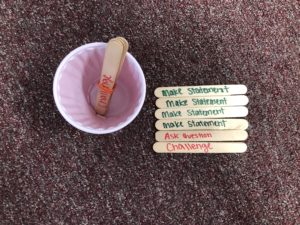I remember late April of my rookie year as a teacher. I was toast! All my great teaching strategies were worn out. I was scrambling trying to find innovative and engaging ways to present lessons. It was a loooooong 6-weeks till summer vacation.
In early June when I did my post-mortem on the year, I vowed to always keep some ideas in the vault for that last 6-weeks home stretch. In fact, I’ve always encouraged rookie teachers to do the same.
I have 5 weeks left of school. The weather is warming up here in the Buckeye state. The springtime panorama, which is the window of my classroom, is getting darned inviting. Conversely, reliable teaching strategies are becoming a bit stale. They’ve worked brilliantly all year, but now with the end in sight, I have to change things up in order to maintain that crucial student engagement.
This episode I’ll focus on keeping my favorite learning activity, the structured class discussion, fresh with the help of a great technique, Talking Sticks. Jen Wilson, who was featured in Episode 117 encouraged me to try this tactic. I was game! Here’s an article from Education World which promotes Talking Sticks, but this activity can absolutely be used at any level. And one final caveat…as with all class discussions, it’s essential that you assign provocative prep material.
Talking Sticks is truly student-led learning. I broke my class up into groups of 4. I arranged them in these groups in a large area, which in my case was the school library. Each group was stationed at a table. One youngster in the group acted as the moderator. Their job was to manage the discussion topic. They first distributed the six talking sticks to the other members of the group.
Each member of the group got 2 sticks. These sticks were either green, Make a Statement, or red, Ask a Question or Challenge an Idea. Once the sticks were distributed, the moderator came to me to get the prompt:
The moderator returns to their station, reads the prompt, and then encourages participants to chime in. When a group member makes a valid statement, asks a question, or challenges an assertion, they can drop their stick in the cup. When I call time, typically, I’d designate about 5 minutes for each topic, group members who’re empty-handed get full credit.
Then, and this part is crucial, I’d mix the groups. Each moderator would move to a new table and become a standard group member. New Moderators would be selected and the process would begin again. It was an awesome experience and the time period flew by.
An observer complimented me on the self-evaluation rubric that students completed as the conversations unfolded. Feel free to make copies.
Episode Template
The Problem:
Even tried and true teaching strategies become stale as the school year starts to draw to a close.
The Solution:
Energize your next structured class discussion utilizing Talking Sticks.
What you can do Tomorrow:
- Find then assign provocative prep material based on your current unit
- Create provocative discussion prompts
- Download my Talking Sticks Rubric and morph it to fit your class
- Pull a kid out of study hall and task them with creating the sticks
- Reserve the Library, or any large space, so that you’ll have plenty of room
Late in the year, you need to be supple and experiment with new teaching strategies to keep them engaged. Talking Sticks is absolutely worth a try.
Listen to “118-Keeping it Fresh with Talking Sticks.output” on Spreaker.

